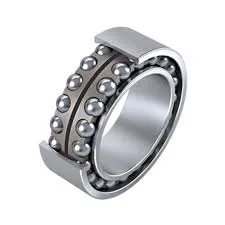
Dec . 25, 2024 03:52 Back to list
Single Direction Thrust Ball Bearing for Efficient Axial Load Support and Stability
Understanding Single Direction Thrust Ball Bearings
Thrust ball bearings are specialized components designed to support axial loads, allowing for efficient rotation and movement in various mechanical applications. Among the variations of thrust ball bearings, single direction thrust ball bearings play a crucial role due to their unique design and functionality. This article will delve into the characteristics, applications, advantages, and maintenance of single direction thrust ball bearings.
What is a Single Direction Thrust Ball Bearing?
A single direction thrust ball bearing consists of two grooved rings and a set of spherical balls positioned between them. The critical feature that distinguishes this type of bearing from others is its ability to support axial loads in only one direction. This design makes it ideal for applications where forces are primarily applied in one direction.
The inner ring is typically mounted on a shaft, while the outer ring is fixed to a housing. The balls roll between the two rings, facilitating smooth rotational movement while minimizing friction. Due to their design, single direction thrust ball bearings are proficient at handling high-speed applications and significant axial loads.
Key Characteristics
1. Load Direction As the name suggests, single direction thrust ball bearings are designed to resist thrust (axial) loads in one direction only. If reverse thrust is expected, a separate bearing must be used.
2. Simple Design The straightforward construction of single direction thrust ball bearings allows for ease of installation and maintenance.
3. Material Composition Typically made from high-quality steel or ceramic, these bearings exhibit excellent durability and resistance to wear and corrosion, ensuring a long service life.
4. Limited Radial Load Handling While adept at handling axial loads, it’s essential to note that these bearings should not be subjected to substantial radial loads, as they are not designed for such scenarios.
Applications
Single direction thrust ball bearings are widely used in various industries, including
- Automotive These bearings can be found in clutches, gear systems, and various components where axial load support is essential. - Aerospace In aircraft and spacecraft applications, reliable thrust bearings are critical for ensuring safety and performance. - Industrial Machinery Many types of machinery, such as conveyor systems and hydraulic pumps, utilize single direction thrust ball bearings for efficient operation.
thrust ball bearing single direction

Advantages
Several advantages make single direction thrust ball bearings a preferred choice in many applications
1. High Load Capacity They can bear substantial axial loads, making them suitable for heavy machinery and equipment.
2. Reduced Friction The ball design allows for minimal contact with the rings, leading to lower friction and heat generation, thus enhancing efficiency.
3. Longevity High-quality materials and effective design contribute to longer service life, reducing the need for frequent replacements.
4. Easy Installation and Maintenance With their relatively simple structure, these bearings are user-friendly, allowing for quick installation and ease of maintenance.
Maintenance and Care
To ensure the longevity and efficiency of single direction thrust ball bearings, proper maintenance is vital. Consider the following tips
- Regular Lubrication Keep the bearing well-lubricated with appropriate grease or oil to minimize wear and tear. - Inspection Regularly check for signs of wear, misalignment, or contamination, addressing any issues promptly to avoid failures.
- Temperature Monitoring Excess heat can lead to bearing damage. Monitoring operational temperatures can help in maintaining optimal performance.
Conclusion
Single direction thrust ball bearings are integral components in various mechanical applications, providing reliable axial load support while promoting efficient movement. Understanding their characteristics, advantages, and maintenance requirements is essential for engineers and technicians to ensure optimal performance and longevity. By choosing the right bearing and implementing proper care, industries can maximize efficiency and reduce downtime in their operations, ultimately leading to enhanced productivity and profitability.
Latest news
-
Premium Deep Groove Ball Bearings | High Speed & Reliability
NewsAug.29,2025
-
Durable Scaffolding Clamps - Secure & Reliable Tube Connectors
NewsAug.28,2025
-
Common Failures in Thrust Ball Bearings and Solutions
NewsAug.22,2025
-
How Tapered Roller Bearings Can Take Shock Loads
NewsAug.22,2025
-
Angular Bearings in High-Precision Spindles
NewsAug.22,2025
-
The Impact of Misalignment on Cylindrical Roller Bearing Performance
NewsAug.22,2025
